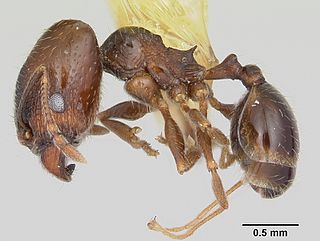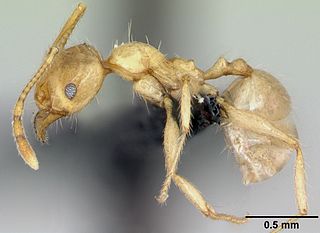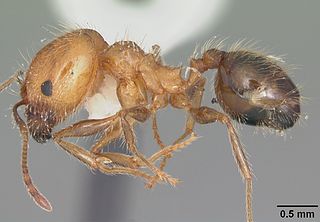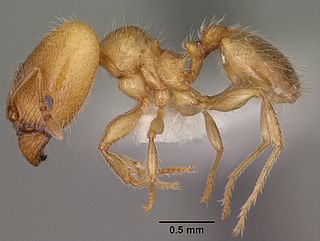
Pheidole is a genus of ants that belongs to the ant subfamily Myrmicinae. The genus is widespread and ecologically dominant. It probably includes more than 1000 species. The genus first evolved in the Americas, eventually spreading across the globe.
Pheidole acutidens is a species of ant in the genus Pheidole. It is endemic to Argentina.
Pheidole argentina is a species of ant in the genus Pheidole. It is endemic to Argentina.

Pheidole elecebra is a species of ant in the genus Pheidole. It is endemic to the United States.
Pheidole symbiotica is a species of ant in the genus Pheidole. It is endemic to Argentina.
Pheidole bula is a species of ant in the genus Pheidole. It was discovered in Fiji, and described by E. M. Sarnat in 2008.
Pheidole elongicephala is a species of ant in the genus Pheidole. It was discovered and described by Eguchi, K. in 2008.
Pheidole laevithorax is a species of ant in the genus Pheidole. It was discovered and described by Eguchi, K. in 2008.
Pheidole ochracea is a species of ant in the genus Pheidole. It was discovered and described by Eguchi, K. in 2008.
Pheidole pegasus is a species of ant in the genus Pheidole. It was discovered and described by Sarnat, E. M. in 2008.
Pheidole vieti is a species of ant in the genus Pheidole. It was discovered and described by Eguchi, K. in 2008.

Pheidole megacephala is a species of ant in the family Formicidae. It is commonly known as the big-headed ant in the USA and the coastal brown ant in Australia. It is a very successful invasive species and is considered a danger to native ants in Australia and other places. It has been nominated as one of the hundred "World's worst" invaders.

Chimaeridris is a small genus of ants in the subfamily Myrmicinae. The genus contains two species known from tropical Asia. Their unique hook-shaped mandibles and similar appearance to Pheidole minor workers raises the possibility that the genus is a slave-maker of Pheidole ants or a specialized predator.

Acanthomyrmex humilis is a species of ant that belongs to the genus Acanthomyrmex. It was described by Eguchi, Bui and Yamane in 2008, and is abundant in Vietnam.

Pheidole pallidula is a species of ant in the genus Pheidole. It is widespread around the Mediterranean.

Pheidole dentata is a species of ant in the genus Pheidole. It is distributed in North America, from the Mid-Atlantic states and southeastern United States to Mexico.

Pheidole bicarinata is a species of ant in the genus Pheidole. It is distributed across United States, from Nebraska, Colorado, Texas, Utah and Nevada, east to New Jersey and Florida.

Pheidole clavata is a species of ant in the genus Pheidole. Pheidole clavata inhabits Eastern and Northern Africa. This species of Pheidole, like many others, are dimorphic, which means that a colony may contain one or several queens. Each colony is made up of two castes: the "minor" workers, and the "major" workers, or "soldiers". The majors have large heads that they use as both weapons and tools to cut open large prey for the colony. The latter generally have enormous heads and mandibles in comparison to their usually fairly modest body size.








